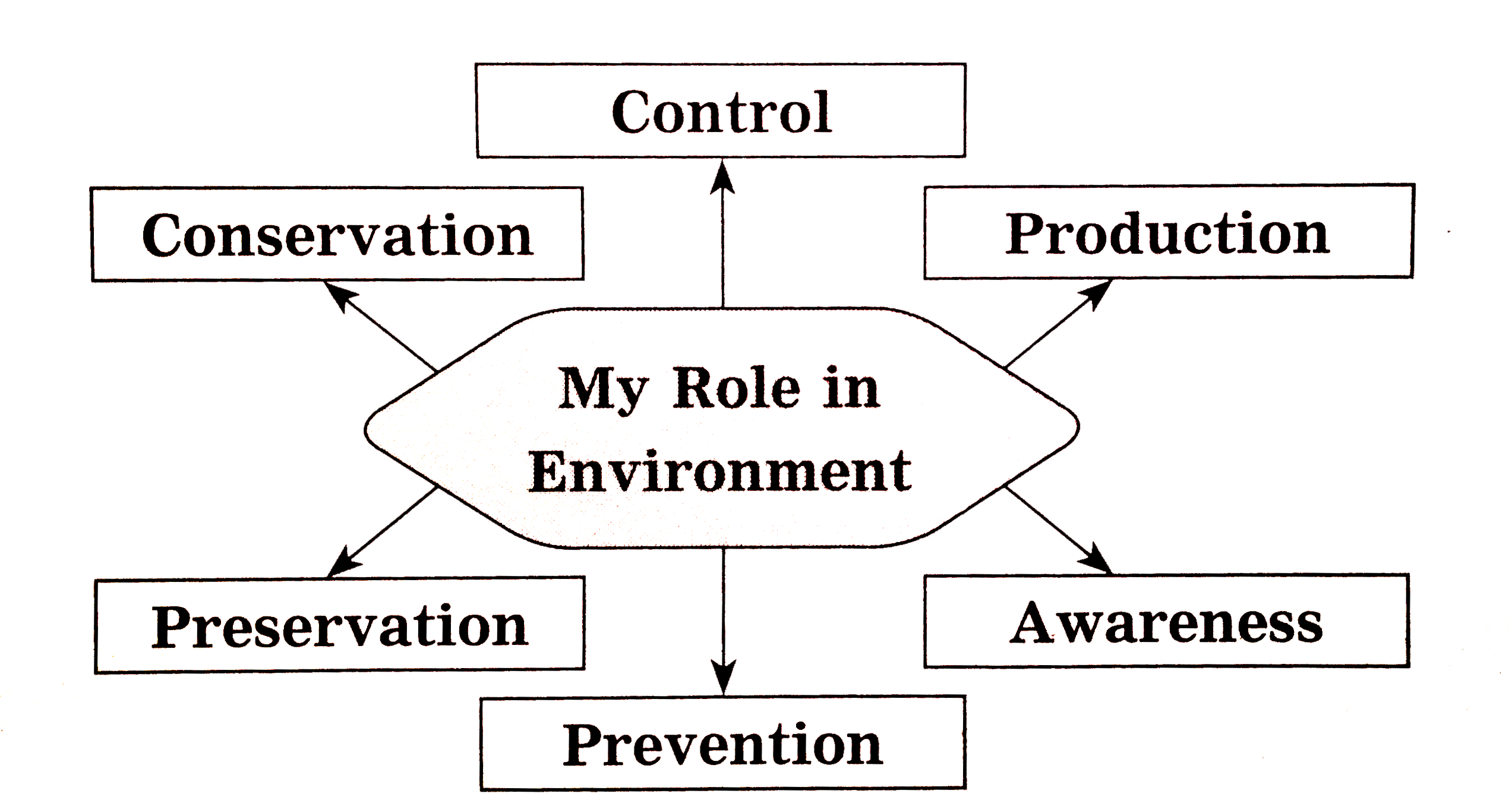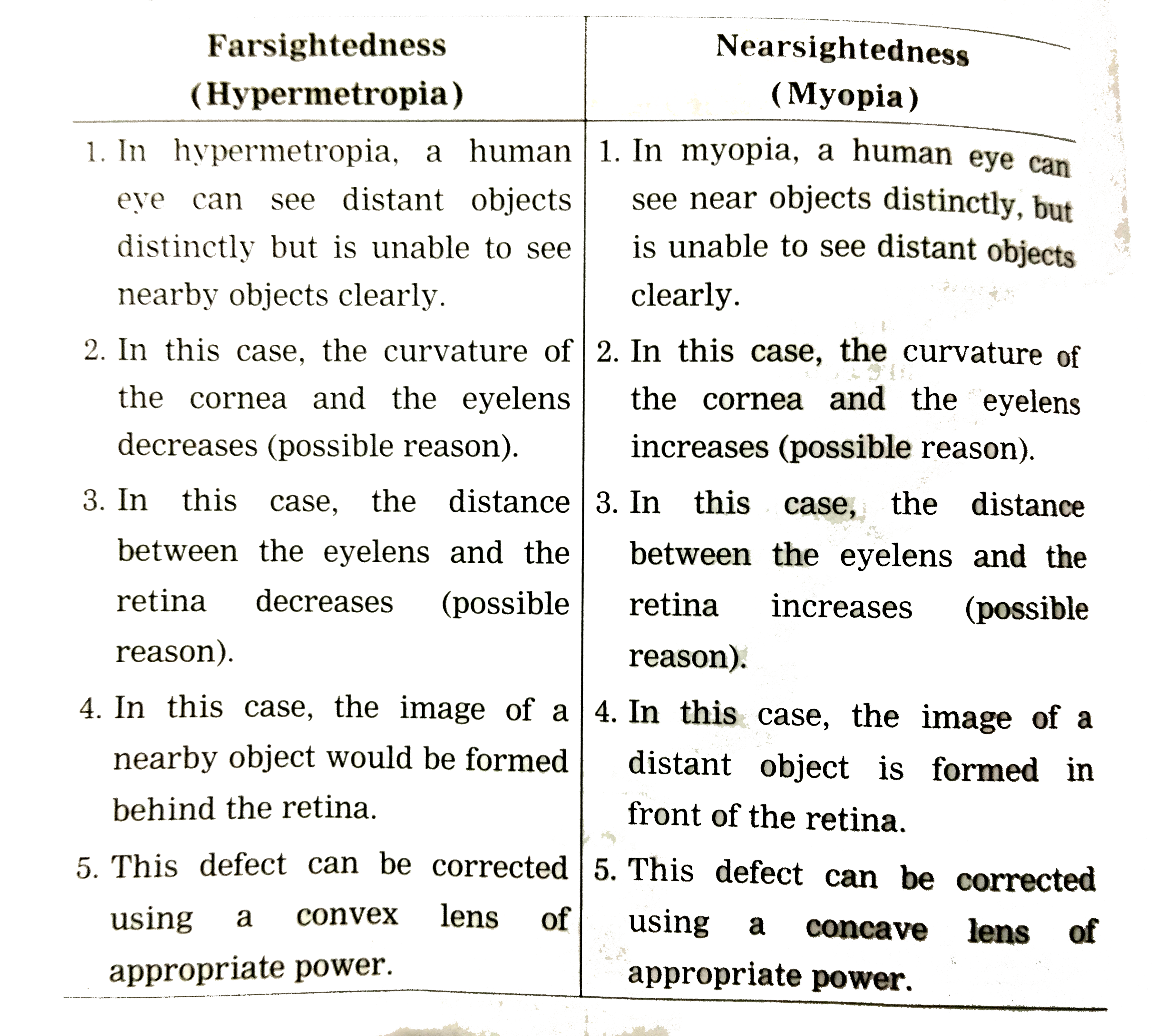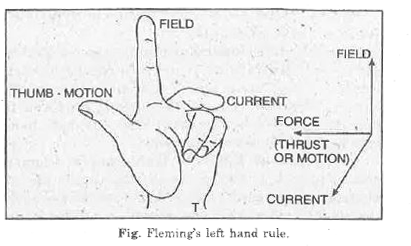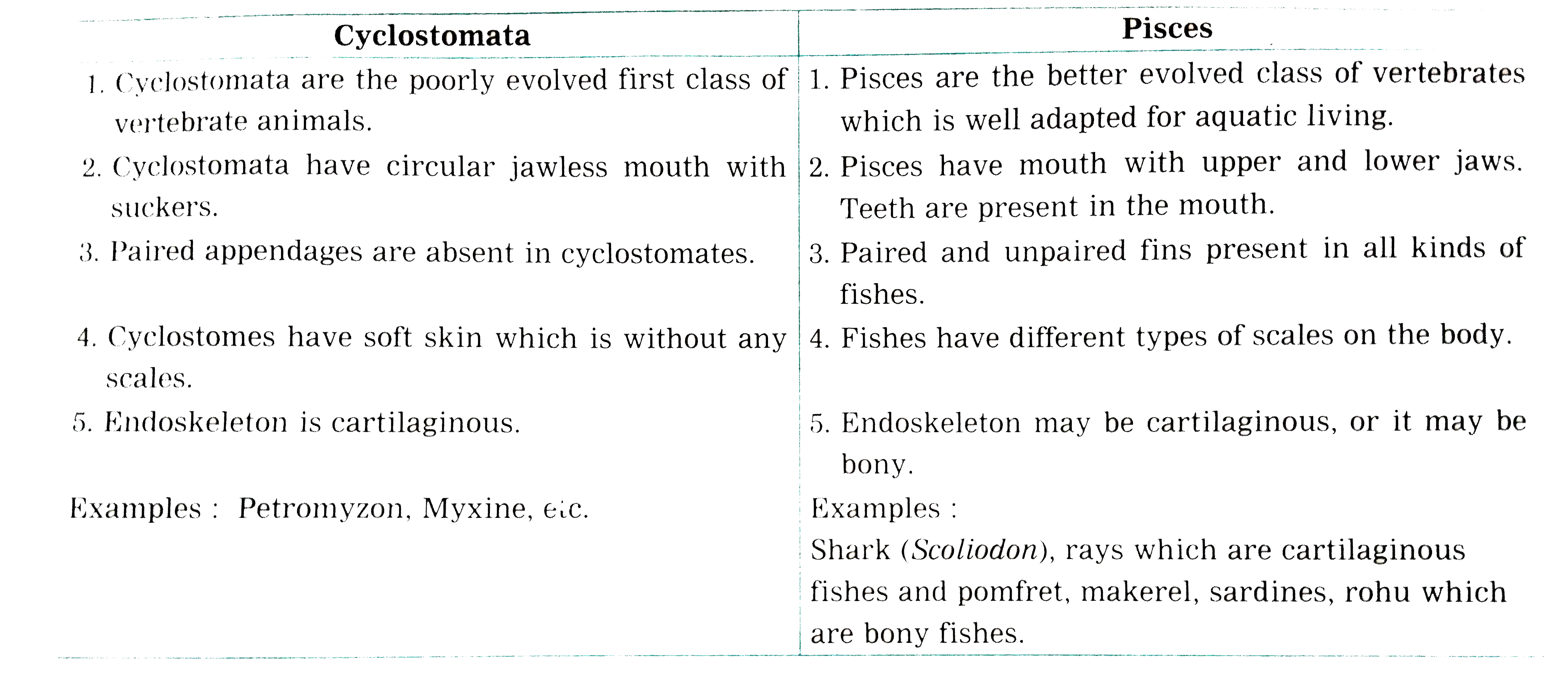InterviewSolution
This section includes InterviewSolutions, each offering curated multiple-choice questions to sharpen your knowledge and support exam preparation. Choose a topic below to get started.
| 4051. |
Sketch the concept diagram showing important role in environment conservation . Give one example each of the said roles . |
Answer» Solution : (1) Control : I will control the use of water . (2) Conservation : I will not waste any natural resource such as food , clothing . (3) Production : I will plant trees and help in developing forests. (4) Preservation : I will not allow anybody to cut down the trees . I will take care of birds and animals . (5) Prevention : I will participate in "clean the beaches" campaign. I shall prevent those who LITTER natural water bodies . (6) Awareness : I will work for important issues such as CLIMATE change by CARRYING out awareness CAMPAIGNS. |
|
| 4052. |
When train stops, the passenger move forward, It is due to ……………………. |
|
Answer» Inertia of passenger |
|
| 4053. |
We hear and read about female foeticide, which is really is a wrong practice. In some families, be it rural or urban, females are tortured for giving birth to a girl child. They do not seem to understand the scientific reason behind the birth of a boy or a girl. Answer the following questions based on the information given above. (i) In your opinion, is the approach of the society towards mother in this regard correct? Explain the scientific reason. (ii) How can you promote awareness among people? (iii) What values will you be promoting by doing so? |
|
Answer» Solution :(i) In my opinion the above approach of society is baseless. Sex of CHILD is determined by TYPE of chromosome present in sperm (X or Y) that fuses with ovum at the time of fertilisation. (ii) By organising poster making, DEBATES and seminars. (III) Spreading social awareness against various social malaise viz. gender inequality, female foeticide, ETC. |
|
| 4054. |
The human eye forms the image of an object at its. |
|
Answer» cornea |
|
| 4056. |
What will be the resistance of a bulb of power 40 W which is connected to a voltage source of 220V? |
|
Answer» SOLUTION : Data : P= 40 W, V = 220 , V , R = ? ` P = VI = V( V/R)= V^(2)/R` `R= V^(2)/P = ((200 V)^(2))/( 40 W) = ( 220 xx 220)/40 Omega= (220 xx 220)/ ( 2 xx 20) = Omega` ` = 11 xx110 Omega = 1210 Omega` The resistanceof the bulb = `1210 Omega` |
|
| 4057. |
The refractive index of water is (4)/(3) and glass is 3/2. What is the refractive index of glass with respect to water ? |
|
Answer» Solution :Given: `""_(a)mu_(G)=("refractive index of glass")/("refractive index of water")` or `""_(W)mu_(g)=(""_(a)mu_(g))/(""_(a)mu_(w))=(3//2)/(4//3)=(9)/(8)=1*125`. |
|
| 4058. |
A lens which collects image at back of telescope is |
| Answer» Answer :A | |
| 4059. |
……………. Is achieved by changing the focal length of the lens with the help of ciliary muscles. |
| Answer» SOLUTION :POWER of ACCOMMODATION | |
| 4060. |
In a bramah press, force, force acting on the right piston is …………….. |
|
Answer» `F_(2)=(A_(1)xxF_(1))/(A_(2))` |
|
| 4061. |
An uncontrolled nuclear chain reaction in nuclear fission forms the basis of : |
|
Answer» NUCLEAR POWER plant |
|
| 4062. |
Consider a source moving towards an listener at a speed of 0.9v. Where v is the velocity of sound. Calculate the apparent frequency if the actual frequency is 600 Hz. |
|
Answer» SOLUTION :Apparent frequency, `N.=((v)/(v-v_(s)))n` `v_(s)=0.9v,n=600Hz` `n.=((v)/(v-0.9v))600=((v )/(v(1-0.9)))600=(1)/(0.1)XX600` `n.=6000Hz` |
|
| 4063. |
The ratio of the potential difference to the current is known as __________. |
|
Answer» |
|
| 4064. |
What happens to the size of the image when the object is brought from infinity closer to (a) concave lens (b) convex lens ? |
|
Answer» Solution :(a) When the OBJECT is brought from infinity CLOSER to a concave lens, the IMAGE size slowly increases, but the size of the image is diminished when COMPARED to size of object. (b) When the object is brought from infinity closer to a CONVEX lens, the image size increases, after a certain position, the image size is magnified when compared to the size of the object. |
|
| 4065. |
Why do we prefer a convex mirror as a rear-view mirror in vehicles? |
| Answer» Solution :It is because, it covers a wide REAR field and FORMS SMALL, ERECT and virtual image, close to the eye of the driver of the vehicle | |
| 4066. |
Explain the perception of colour of the human eye . |
|
Answer» Solution :In nature wefind objects of various colours. Perception of colour means to be able to respond to colour. (2) We can distinguish between various colours due to preceptionof colour . (3)The cone-shaped cells on the retina of the EYE respond to thevarious colourswhen lightis brightand communicate to the brain about the colours of the imageformed on the retina. This gives us the proper idea about the coloursof the object. (4)If, in the retina of a person, the cone-shaped cells responding to CERTAIN SPECIFIC colours are absent, the person is unable to distinguish between the colours . As a result, he LACKS perception of colour. |
|
| 4067. |
The refractive index of a transparent medium is always greater than __________. |
|
Answer» two |
|
| 4068. |
For the same kinetic energy of a body ,what should b the changes in its velocity if its mass is increased four times? |
|
Answer» Solution :Let initial MASS `m_(1)` velocity =`v_(1)` Final mass `m_(2)`=4M velocity =`v_(2)` For the same kinetic energy , `(1)/(2)m_(1)v_(1)^(2)` or `(1)/(2)MV^(2)=(1)/(2)xx4mxxv_(2)^(2)` or `v_(2)^(2)=(1)/(4)v^(2)` or `v_(2)=(1)/(2)v ` |
|
| 4069. |
Assertion : All the radioactive element are ultimately converted in lead. Reason : All the elements above lead are unstable. |
|
Answer» If both the assertion and the REASON are true and the reason is the CORRECT explanation of the assertion. |
|
| 4070. |
What is the principle of an electric motor ? |
| Answer» Solution :An electric motor is based on the principle that a current-carrying CONDUCTOR experiences a FORCE when PLACED in a MAGNETIC field. If the direction of the magnetic field and that of the current are mutually perpendicular then the direction of the force is GIVEN by Fleming.s left-hand rule. | |
| 4071. |
Write the functions of epiglottis. |
| Answer» Solution :The FUNCTION of EPIGLOTTIS is to prevent the entry of food into the TRACHEA through the GLOTTIS. | |
| 4072. |
A coin kept inside water (mu=4//3) when viewed from air in a vertical direction, appears to be raised by 2*0mm. Find the depth of the coin in water. |
|
Answer» Solution :Given: `mu=(4)/(3)`, shift=`2*0mm` Let REAL depth be x mm. then Apparent depth`=(x)/(mu)=(x)/(4//3)=(3)/(4)x` Shift=real depth-apparent depth `=x-(3)/(4)x=(1)/(4)x` Given shift `(1)/(4)x=2*0mm""thereforex=8*0mm` Thus depth of coin in water=`8*0`mm. |
|
| 4073. |
A boat having a length of 3m and breath 1m is floating on a lake. The boat sinks by one cm when a person gets on it. The mass of the person is |
|
Answer» 60 KG |
|
| 4074. |
The apparent weight of an object ________ in an elevator while accelerating upward. |
| Answer» SOLUTION :INCREASES | |
| 4075. |
250L of an ideal gas is heated at constant pressure from 27%(@)C such that its volume becomes 500L. The final temperature is |
|
Answer» <P>`54^(@)C` |
|
| 4076. |
A unit vector is a………………………and…………………………………… . |
|
Answer» UNITLESS, not dimensionless |
|
| 4077. |
Carbon cannot reduce the oxides of sodium, magnesium and aluminium to their respective metals. Why ? Where are these metals placed in the reactivity series? How are these metals. obtained from their ores ? Take an example to explain the process of extraction along with chemical equations. |
|
Answer» Solution :• This is because magnesium and aluminium lie higher than carbon in the activity series. Elements LYING lower in activity series cannot reduce oxides of elements lying higher in the activity series. • These METALS are PLACED higher in the activity series. • These metals are obtained by electrolytic reduction. • For example, sodium is obtained by electrolysis of MOLTEN sodium chloride. At cathode : `NA^(+) + e^(-)rarrNa` At anode : `2Cl^(-)rarrCl_2 + 2e^(-)` |
|
| 4078. |
"A concave mirror of focal length 'f' can form a magnified erect aswell as an inverted image of an object placed in front of it. " Justify this statement stating the position ofthe object with respectto the mirror in each case for obtaining these images. |
|
Answer» Solution :When the OBJECT is placed at a distance less than 'F' (focal LENGTH) from the MIRROR, the IMAGE formed is virtual, magnified and erect. When the object is placed at a distance of 'f' (focal length) from the mirror, the image is real, inverted and highly magnified. When the object is placed at a distance more than 'f' (focal length) but less than '2f', the image formed is real, inverted and magnified. When the object is placed at the distance of 1'2f' from the mirror, the image is real, inverted and same size of the object. When the object is placed at a distance more than '2f' from the mirror, the image formed is real, inverted and diminished. |
|
| 4079. |
A beam of light is allowed to pass through two beakers A and B, containg a true solutionand a colloidal solution respectively. What do you observe ? Name the phenomenon responsible for your observation. |
Answer» Solution :Aim of the activity: To study Tyndall effect or scattering of light by colloidal particles.  (1) Place a strong source of white light (S), a convex lens `[L_(1)]`, a transparent glass tank [T] containing clear water [about 2 litres], a cardboard [C ] with a circular hole, another convex lens `[L_(2)]` and a screen [MN] in a straight line as SHOWN in the figure. (2) Focus white light from S into `L_(1)` so that a parallel beam of light is obtained. (3) This beam of light passes through T, the hole in the cardboard, `L_(1)` and finally falls on the screen. (4) Dissolve about 200 g of sodium thiosulphate (hypo-chemical formula `Na_(2)S_(2)O_(3)`) in the tank water and later add 1-2 ml of CONCENTRATED sulphuric ACID into it. Inference : Sulphur particles starts precipitating in about 2-3 minutes and blue light starts coming from three sides of the glass tank. This is because minute sulphur particles scatter light of short wavelengths [blue colour] to a maximum extent. This helpsus to understand why or sky appears blue. We also observe that initially orange light comes out of the fourth side of the tank [the one facing the circular hole] and falls on the screen, Later the colour changes by scattering and the least scattered red light comes out of the colloidal solution. This helps us to understand why the sun appears red during SUNRISE or sunset. |
|
| 4080. |
A myopia person can see things clearly only when they lie between 10 cm and 80 cm from the eye. Which lens would enable him to see the moon clearly ? |
|
Answer» <P> SOLUTION :Given, far POINT x = 80 cm.To SEE the moon clearly, he has to use spectacles with concave LENS of focal length, f = -x = -80 cm Power, `= -1.25 D P = (80)/(f)` |
|
| 4081. |
The motion of a particle of mass m is described by h= ut+1//2 gt^2. Find the force acting on particle. (F=mg). |
|
Answer» Find a by DIFFERENTIATING h twice w.r.t. a=g as F=ma so F=mg |
|
| 4082. |
A device for producing intense and coherent (waves in step) beam of light is called |
|
Answer» LASER |
|
| 4083. |
Farsightedness (Hypermetropia) and Nearsightedness (Myopia). |
Answer» SOLUTION :
|
|
| 4084. |
State Fleming's left hand rule. |
Answer» SOLUTION :Fleming.s left hand rule. STRETCH the thumn, fore finger and middle finger of your left hand such that they are mutually perpendicular to each other. If the FIRST finger points in the direction of magnetic FIELD and central (second) finger points towards the direction of current then thumb points towards the direction of thrust, force or towards motion as shown in Fig. 
|
|
| 4085. |
Derive a formula that shows the relation between resistance length and area of cross section of a conductor. |
|
Answer» Solution :1. Resistance of a CONDUCTOR `(R)` is directly proportional to its length (l) for a constant potential DIFFERENCE. `Ralphal""-(1)` 2. Resistance of a conductor is inversely proportional to its cross section area. `Ralpha(1)/(A)""-(1)` 3. From (1) and (2), we get `Ralpha(1)/(A)` (at constant temperature) `rArrR=(rho1)/(A)` Where, `rho` is a proportionalty constant and it is CALLED SPECIFIC RESITANCE or resistivity. 4. The S.I. unit of resistivity is `Omega-m.` |
|
| 4087. |
What is the capacity of a fuse commonly used in domestic electrical fittings? |
| Answer» SOLUTION :FUSES of capacity 5 ampere or 15 ampere are commonly USED in domestic ELECTRICAL fittings. | |
| 4088. |
A human eye can focus on objects at different distance by adjusting the focal length of the eye lens. This phenornenon is due to |
|
Answer» Near SIGHTEDNESS |
|
| 4089. |
(i) Name the device used to convert : (a) Solar energy into heat. (b) Solar energy into electricity. (ii) Mention two limitations of solar energy. |
|
Answer» Solution :(i) (a) Solar cooker (b) Solar cell. (ii) Two Limitations : (a) Solar heating DEVICES are USEFUL only at certain times during the day. (b) HIGH cost and low EFFICIENCY of solar cell panels. |
|
| 4090. |
Explain, why electric power is transmitted at low current to distant places . |
| Answer» Solution :Electrical power P = VI = `1^(2) R`and from Ohm.s law, V = IR . At constant resistance, electrical power is DIRECTLY proportional to voltage and square of current. Thus, if current is KEPT low, power loss during transmission is reduced SIGNIFICANTLY. | |
| 4091. |
What type of reactions occurring inside the sun produce solar energy ? |
|
Answer» |
|
| 4092. |
Explain potential energy with the help of a bow. |
|
Answer» Solution :1) TAKE a bamboo stick and make a bow as shown in figure. 2) Place an arrow made of a light stick on it with one end SUPPORTED by the string of the bow and stretch the string gently and release the arrow.  3) We notice that the arrow gets SEPARATED from the bow and falls down on the ground. 4) Now place the arrow on the bow with one end supported by the string, applying more FORCE and release the arrow. 5) We observe that the arrow lies with great speed into the air. 6) From this we can conclude that the bow in normal shape is not able to push the arrow, but when we stretch the string, it acquires ENERGY to throw the arrow into air with great speed. 7) The energy acquired by the bow due to change in its shape is known as its potential energy. |
|
| 4093. |
The strength of the magnetic field around a current-carrying straight conductor |
|
Answer» is same every where around the CONDUCTOR. |
|
| 4094. |
A body falls from a height H. Its velocity (v)-distance (x) graph is |
|
Answer»
|
|
| 4095. |
What happens to the resistsance of a conductor if we increse its length ? |
| Answer» SOLUTION :The RESISTANCE of a CONDUCTOR INCREASES with the increases of its LENGTH. | |
| 4096. |
Cyclostomata and Pisces. |
Answer» SOLUTION :
|
|
| 4097. |
In a myopic eye, the image of the object is formed |
|
Answer» BEHIND the retina |
|
| 4098. |
In cold countries , in wingter, even when the water of lakes freezes, aquatic animals and plants can survive. How do you think it is possible? Explain in detail. |
| Answer» Solution :(1) In cold countries , in winter, a layer of ice is formed on the surface of LAKES when the ATMOSPHERIC temperature falls below `0^(@0C `. However, below this layer, there is water at `4^(@)C ` . (2) Ice,being a bad CONDUCTOR of heat, does not allow transfer of heat from this water to the atmosphere.Hence, aquatic animals can SURVIVE in this water. | |
| 4099. |
To which phylum does Cockroach belong? Justify your answer with scientific reasons. |
|
Answer» Solution :(1) Cockroach belongs to the phylum Arthropoda and class Insecta. (2) Scientific REASONS for placement of Cockroach in the phylum Arthropoda : (a) The body is covered by chitinous exoskeleton. (b) JOINTED appendages present, THREE Pairs of walking legs and two pairs of membranous wings. (c) Body is eucoelomate, triploblastic, bilaterally SEGMENTED and segmented. (d) Respiration by spiracles and TRACHEAL tubes. |
|
| 4100. |
A student want to project the image of a candle flame on the walls of school laboratory by using a lens: (a) Which type of lens should he use and why? (b) At what distance in terms of focal length 'F' of the lens should he place the candle flame so as to get (i) a magnified, and (ii) a diminished image respectively on the wall? (c) Draw ray diagram to show the formation of the image in each case. |
|
Answer» Solution :(a) A convex LENS should be USED. This is because it can produce a real image of the candle flame on the wall as it is a converging lens where refracted ray actually meet. (b) & (c )(i) A real MAGNIFIED image is formed when the candle flame is placed between F and 2F from the convex lens on the other SIDE of the wall.  (ii) A real diminished image is formed when the candle flame is placed beyond 2F from the convex lens on the other side of the wall. 
|
|